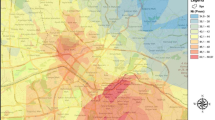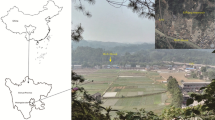Abstract
A total of 540 topsoil samples (0–15 cm), 188 subsoil samples (20–40 cm), and four individual soil profiles were collected in this study for mapping the Cu- and Pb-contaminated areas in soils of Zhangjiagang city, an industrialized city in the Yangtze River Delta region of China. Robust geostatistical methods were applied for identifying possible spatial outliers of Cu and Pb data, and then a sequential Gaussian simulation was employed for delineating the potential areas where Cu or Pb concentration was affected by diffuse pollution. The results showed that the spatial outliers of Cu and Pb were strongly associated with various types of factories. The anthropogenic input of Cu to soils at local hotspots was closely related to emissions of printing and dyeing, metallurgical, and chemical factories, whereas a lead oxide factory and a chemical factory resulted in a considerable increase of Pb in the topsoil of the study area. Approximately 30% of the total land area of the study was at potential risk from the Cu or Pb diffuse pollution resulting from rapid industrialization of the area over the past 20 years.










Similar content being viewed by others
References
Agricultural Environment Background Value Research Group (1997) Studies on agricultural environment background values of China (in Chinese). Shanghai Science and Technology Press, Shanghai, pp 165
Atteia O, Dubois JP, Webster R (1994) Geostatistical analysis of soil contamination in the Swiss Jura. Environ Pollut 86:315–327
Burt R, Wilson MA, Mays MD, Lee CW (2003) Major and trace elements of selected pedons in the USA. J Environ Qual 32:2109–2121
Cattle JA, McBratney AB, Minasny B (2002) Kriging method evaluation for assessing the spatial distribution of urban soil lead contamination. J Environ Qual 31:1576–1588
Chang AC, Warneke JE, Page AL, Lund LJ (1984) Accumulation of heavy metals in sewage sludge-treated soils. J Environ Qual 13:87–91
Cressie N, Hawkins D (1980) Robust estimation of the variogram. Math Geol 12:115–125
Deutsch CV, Journel AG (1998) GSLIB, Geostatistical software library and user’s guide. Oxford University Press, New York
Dowd PA (1984) The variogram and kriging: robust and resistant estimators. In: Verly G, David M, Journel AG, Marechal A (eds) Geostatistics for natural resources characterization (Part 1). Reidel, Dordrecht, pp 91–106
Facchinelli A, Sacchi E, Mallen L (2001) Multivariate statistical and GIS-based approach to identify heavy metal sources in soils. Environ Pollut 114:313–324
Franssen HJWMH, van Eijnsbergen AC, Stein A (1997) Use of spatial prediction techniques and fuzzy classification for mapping soil pollutants. Geoderma 77:243–262
Furrer R, Genton MG (1999) Robust spatial data analysis of lake Geneva sediments with S+SpatialStats, Int J Syst Res Inf Sci Spec Issue Spat Data Anal Model 8:257–272
Genton MG (1998) Highly robust variogram estimation. Math Geol 30:213–221
Goovaerts P (1999) Geostatistics in soil science: state-of-the-art and perspectives. Geoderma 89:1–45
Goovaerts P (2001) Geostatistical modeling of uncertainty in soil science. Geoderma 103:3–26
Juang KW, Chen YS, Lee DY (2004) Using sequential indicator simulation to assess the uncertainty of delineating heavy-metal contaminated soils. Environ Pollut 127:229–238
Kuo S, Heilman PE, Baker AS (1983) Distribution and forms of copper, zinc, cadmium, iron, and manganese in soils near a copper smelter. Soil Sci 135:101–109
Lark RM (2000) A comparison of some robust estimators of the variogram for use in soil survey. Eur J Soil Sci 51:137–157
Lark RM (2002) Modelling complex soil properties as contaminated regionalized variables. Geoderma 106:173–190
Li Z, Shuman LM (1996) Heavy metal movement in metal-contaminated soil profiles. Soil Sci 161:656–666
Meuli R, Schulin R, Webster R (1998) Experience with the replication of regional survey of soil pollution. Environ Pollut 101:311–320
Militino AF, Palacios MB, Ugarte MD (2006) Outliers detection in multivariate spatial linear models. J Stat Plan Inference 136:125–146
Mowrer H T (1997) Propagating uncertainty through spatial estimation processes for old-growth subalpine forests using sequential Gaussian simulation in GIS. Ecol Modell 98:73–86
R Development Core Team (2005) R: A language and environment for statistical computing. R Foundation for Statistical Computing, Vienna, Austria. ISBN 3-900051-07-0, URL http://www.R-project.org
Rawlins BG, Lark RM, O’Donnell KE, Tye AM, Lister TR (2005) The assessment of point and diffuse metal pollution of soils from an urban geochemical survey of Sheffield, England. Soil Use Manag 21:353–362
Ribeiro PJ Jr, Diggle PJ (2001) GeoR: A package for geostatistical analysis. R-NEWS, vol 1, No 2, pp 15–18. ISSN 1609–3631
Shao XX, Huang B, Gu ZQ, Qian WF, Jin Y, Bi KS, Yan LX (2006) Spatial-temporal variation of pH values of soils in a rapid economic developing area in the Yangtze River Delta region and their causing factors (in Chinese). Bull Miner Petrol Geochem 25(2):143–149
Soil Survey Office of Shazhou County (SSOSC) (1984) Description of Soils in Shazhou County (in Chinese). Agriculture Bureau of Suzhou City, Jiangsu Provincial Office for Soil Survey
Soil Taxonomy Research Group (STRG) (2001) Key to Chinese Soil Taxonomy (in Chinese). University of Science and Technology of China Press, Hefei
State Environmental Protection Administration of China (1995) Chinese Environmental Quality Standard for Soils (GB 15618-1995) http://www.zhb.gov.cn/eic/650208300142493696/19951206/1023470.shtml
Sterckeman T, Douay F, Proix N, Fourrier H (2000) Vertical distribution of Cd, Pb and Zn in soils near smelters in the north of France. Environ Pollut 107:377–389
Van Meirvenne M, Goovaerts P (2001) Evaluating the probability of exceeding a site-specific soil cadmium contamination threshold. Geoderma 102:75–100
Wang GX, Gertner G, Liu XZ, Anderson A (2001) Uncertainty assessment of soil erodibility factor for revised universal soil loss equation. Catena 46:1–14
Webster R, Oliver M (2000) Geostatistics for environmental scientists. Wiley, New York
Zhang CS, Selinus O (1997) Spatial analyses for copper, lead and zinc contents in sediments of the Yangtze River basin. Sci Total Environ 204:251–262
Acknowledgments
Funding provided by the National Natural Science Foundation of China (40601039), the National Key Basic Research Support Foundation of China (2002CB410810) and the Knowledge Innovation Program of Chinese Academy of Sciences (ISSASIP0604). We gratefully thank Dr Murray Lark (Rothamsted Research) and Dr Barry Rawlins (British Geological Survey) for their help in providing reprints of the related papers.
Author information
Authors and Affiliations
Corresponding author
Rights and permissions
About this article
Cite this article
Zhao, Y., Xu, X., Huang, B. et al. Using robust kriging and sequential Gaussian simulation to delineate the copper- and lead-contaminated areas of a rapidly industrialized city in Yangtze River Delta, China. Environ Geol 52, 1423–1433 (2007). https://doi.org/10.1007/s00254-007-0667-0
Received:
Accepted:
Published:
Issue Date:
DOI: https://doi.org/10.1007/s00254-007-0667-0




